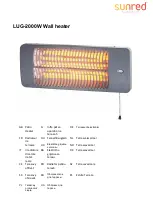
CONNECTIONS
–
PLUMBING
31
A disconnection union must always be provided at the cold water inlet to
the Sunstat valve and hot water outlet on the water heater to allow for
disconnection of the water heater.
This water heater has either a plastic dip tube or fitting liner in the inlet and
outlet fittings (see diagram). These must be in place for the water heater to
function properly. Do not remove or damage them by using heat nearby.
They will be pushed into the correct position as the fitting is screwed in.
Exposed pipe work between the solar storage tank and the penetrations through the roofing material should
be kept to a minimum to maintain the aesthetics of the installation.
Pipes must not be installed in direct contact with metal roofs. Where it is necessary to run piping across a
metal roof, it must be fixed above the roof and surrounded with a weatherproof insulation of a minimum
thickness in accordance with Clause 4.12.3 of AS/NZS 3500.4. The insulation must be UV resistant if
exposed. The insulation is to assist in freeze protection and to protect the metal roof against corrosion by
water runoff over the copper pipe. Consideration should be made for thermal expansion and contraction of
the roof material.
Notes:
Penetrations through the roofing material must be:
at the high point of the roof tile or metal sheet;
made neatly and kept as small as practicable;
waterproofed upon installation of the hot and cold pipes.
PIPE SIZES
To achieve true mains pressure operation, the cold water line to the water heater should be the same size or
bigger than the hot water line from the water heater.
The pipe sizing for hot water supply systems should be carried out by persons competent to do so, choosing
the most suitable pipe size for each individual application. Reference to the technical specifications of the
water heater and local regulatory authority requirements must be made.
IN-SERIES BOOSTER (IF INSTALLED)
The pipe work between the solar storage tank and an in-series booster has a minimum recommended pipe
size of DN20,
MUST BE
of copper and be fully insulated with a closed cell type insulation or equivalent and
in accordance with the requirements of AS/NZS 3500.4. The insulation must be weatherproof and UV
resistant if exposed. The insulation must be fitted up to the connections on both the solar storage tank and
the in-series booster. An isolation valve must be installed on the water line to the in-series booster. The
isolation valve must be of a full flow type if the in-series booster is a continuous flow water heater.
TEMPERATURE PRESSURE RELIEF VALVE
The temperature pressure relief valve is shipped in a plastic bag attached to the side of the water heater.
The temperature pressure relief valve must be fitted before the water heater is operated. Before fitting the
relief valve, make sure the probe has not been bent. Seal the thread with Teflon tape - never hemp. Make
sure the tape does not hang over the end of the thread.
Screw the valve into the correct opening (refer to the
installation diagrams on pages
25
to
26) leaving the
valve drain pointing downwards. Do not use a wrench on the valve body - use the spanner flats provided. A
copper drain line must be fitted to the temperature pressure relief valve (refer to
"Relief Valve Drain"
on
page 32).
Attach the pull cord supplied to the easing lever of the temperature pressure relief valve and extend to a
suitable operating position using the eye screws supplied. Attach the eye screws to a reinforced section of
the guttering or other suitable location (refer to the
installation diagrams on pages
25
to
26).
The valve must be insulated with closed cell polymer insulation or similar (minimum thickness 9 mm) and the
insulation installed so as not to impede the operation of the valve. The insulation must be weatherproof and
UV resistant if exposed.














































